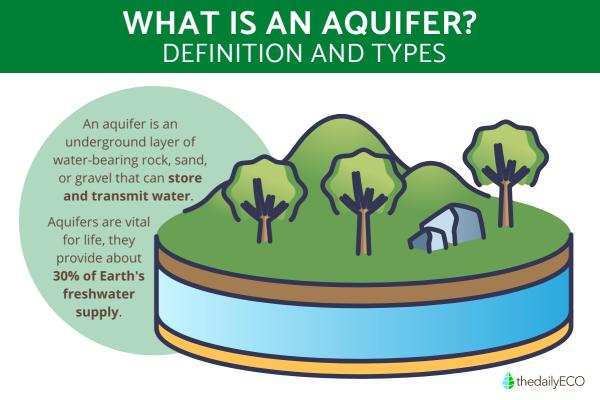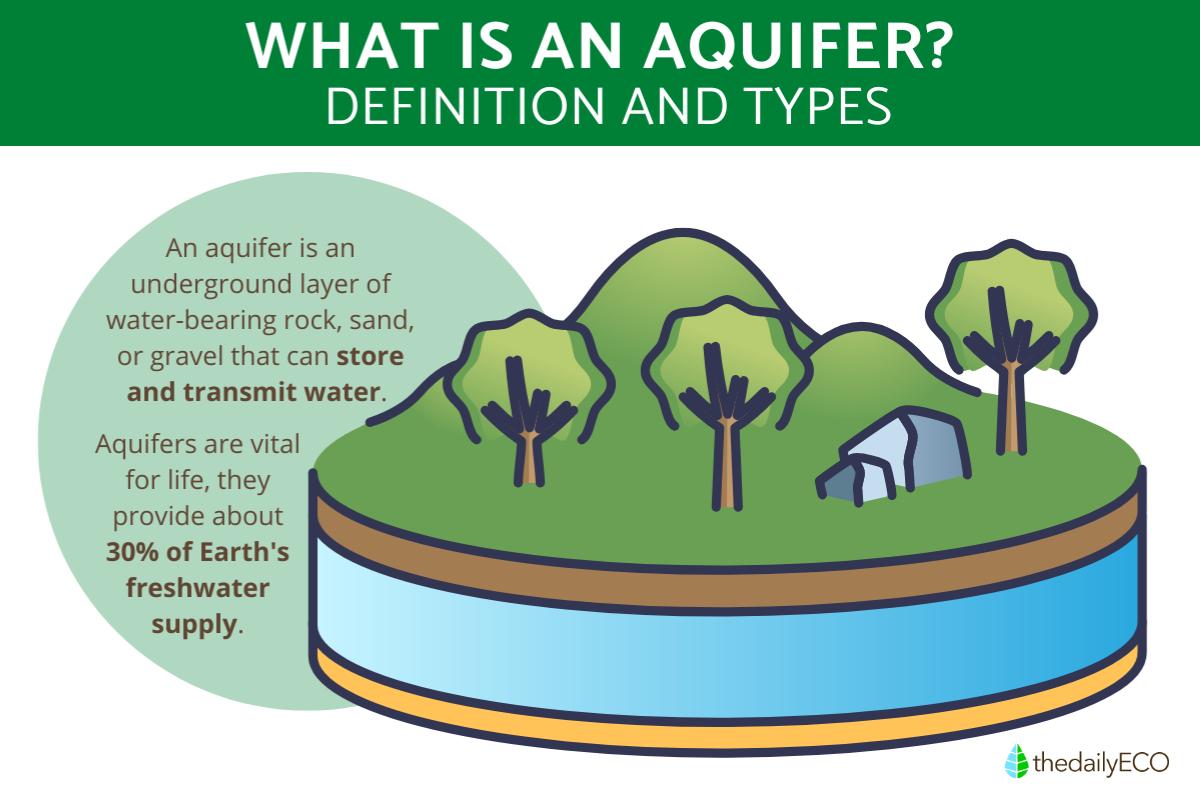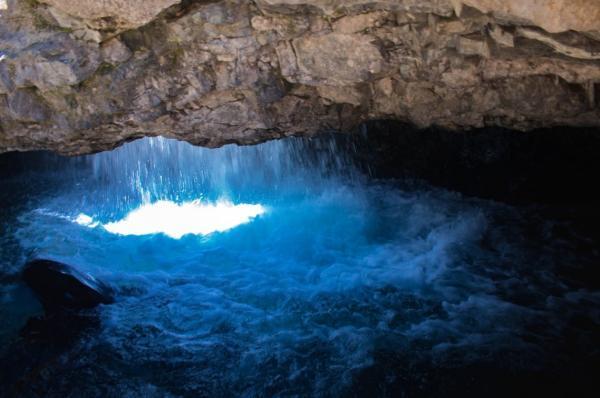What Is an Aquifer?


Aquifers are underground water systems that store and transport groundwater through layers of rock and sediment. These natural reservoirs have shaped human civilization since ancient times, when communities first dug wells to access water. Today, cities and farms worldwide still depend on aquifers for their water supply. As communities face increasing water challenges, understanding how aquifers work becomes more critical.
The following article by thedailyECO explains what aquifers are, how they form, their different types and importance.
What is an aquifer?
An aquifer is a vital underground geological formation that stores and transmits groundwater. The term derives from Latin, combining "aqua" (water) and "fero" (to carry), reflecting its essential function as a natural water carrier.
What are the main parts of an aquifer?
Aquifers consist of several layers that work together to store and move groundwater:
- Water table: the uppermost level of groundwater, marking where atmospheric pressure equals water pressure.
- Vadose zone or Aeration zone: the area between the surface and water table where pores contain both air and water.
- Saturation zone: the region below the water table where rock pores and fractures are completely filled with water.
- Impermeable layer: a dense rock or clay barrier that prevents water from seeping deeper, directing flow horizontally.
Water moves through aquifers via interconnected spaces in rock formations, including:
- Pores between rock particles
- Fractures and fissures
- Natural cavities and dissolution channels
This natural system allows groundwater to travel both vertically and horizontally, sometimes emerging at the surface as springs or connecting to surface water bodies like rivers and lakes. Wondering how water travels before reaching an aquifer? Discover the journey of groundwater in our related article.

How are aquifers formed?
Aquifers form as part of Earth's natural water cycle, beginning with rainwater and snow that seeps into the ground. This process, known as infiltration, is the first step in creating these underground water reserves.
Two main forces work together to create aquifers:
- Gravity: pulls water downward through soil and rock layers, driving the movement of water underground.
- Rock structure: determines how water moves and where it collects, with different rocks creating unique aquifer types.
Not all rocks interact with water the same way. The type of rock greatly influences how aquifers form:
- Sandstone: has tiny spaces between grains that store water.
- Limestone: dissolves over time, creating large water-filled cavities.
- Dense rocks: like granite or clay block water flow, forming natural barriers.
When water can't move further down due to dense rock barriers, it begins to accumulate in the porous rock layers above. These layers act like a natural underground sponge, with water filling the tiny spaces between rock particles, cracks, and cavities. This stored water forms the aquifer.
Over time, aquifers replenish their water supply through a process called recharge. When rain falls or snow melts at the surface, some of this water seeps deep into the ground, gradually making its way down to the aquifer. This natural refilling process is essential for maintaining groundwater supplies.
The speed of recharge varies greatly between different aquifers. Some factors that influence recharge rates include the local precipitation patterns, the types of soil and rock present, the surface vegetation, and how the land above the aquifer is being used. Think of it as a very slow-moving underground river system that continuously receives new water from above, storing it in natural rock reservoirs until it's needed.
Curious about where aquifers fit into Earth's broader water systems? Explore our comprehensive guide to all major water resources.
What are the three types of aquifers?
Based on their geological structure and how water moves through them, there are three primary types of aquifers:
1. Unconfined aquifers or free aquifers:
These are the closest to Earth's surface and have a direct connection to ground level through permeable soil or rock. The water level in these aquifers rises and falls freely with precipitation and usage.
The upper boundary is the water table itself, which can fluctuate seasonally. When the water table intersects the surface, it creates natural features like springs and wetlands.
2. Confined aquifers or artesian aquifers:
These aquifers are sandwiched between two impermeable rock layers, often formed when geological forces bend or tilt rock formations. Water in these aquifers is under pressure higher than atmospheric pressure.
When a well taps into a confined aquifer, this pressure can push water up the well naturally, sometimes even creating an artesian well where water flows freely to the surface.
3. Semi-confined aquifers:
These represent a middle ground between confined and unconfined aquifers. They have partially permeable confining layers that allow some water to slowly seep in or out.
The water pressure in these aquifers equals atmospheric pressure, and they often serve as transition zones between different aquifer systems.
Ready to explore specific examples of these underground water systems? Our detailed guide with visual diagrams will help you understand each type in depth.

The importance of aquifers
Aquifers play a vital role in sustaining life on Earth, serving as natural underground reservoirs that support both human needs and environmental systems.
Aquifers provide about 30% of Earth's freshwater supply. In many regions, they serve as the primary source of drinking water for communities and cities. During droughts, these underground reserves become especially crucial as reliable water sources when surface water is scarce.
Modern agriculture heavily depends on aquifer water for irrigation. These natural reservoirs help farmers maintain crop production year-round, particularly in arid regions or during dry seasons. The consistent water supply from aquifers supports food security for billions of people worldwide.
Aquifers don't just serve human needs. They play an essential role in maintaining healthy ecosystems by:
- Supplying water to rivers, lakes, and wetlands during dry periods.
- Supporting groundwater-dependent ecosystems.
- Preventing saltwater intrusion in coastal areas.
- Maintaining soil moisture for plant life.
Recharge rates vary significantly based on local conditions. Many aquifers refill very slowly, taking decades or even centuries to replenish. This makes them effectively non-renewable when overused.
While aquifers can replenish through natural processes, their sustainability faces several challenges:
- Overextraction from excessive pumping.
- Contamination from industrial and agricultural activities.
- Climate change impacts on recharge patterns.
- Urban development affecting natural recharge areas.
Want to know more about what threatens these underground water reserves? Discover how salt can transform freshwater aquifers in our next article.
If you want to read similar articles to What Is an Aquifer?, we recommend you visit our Environment (other) category.







